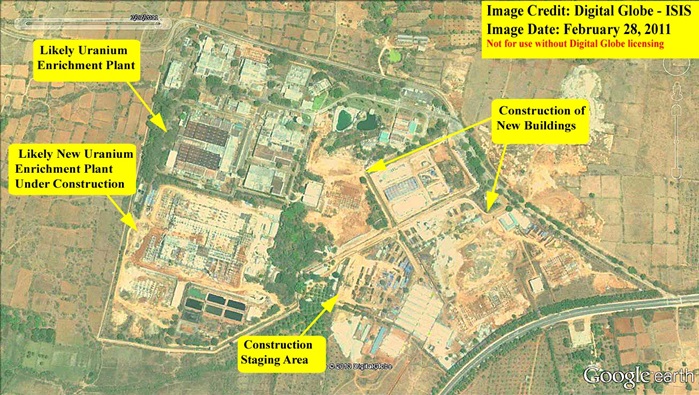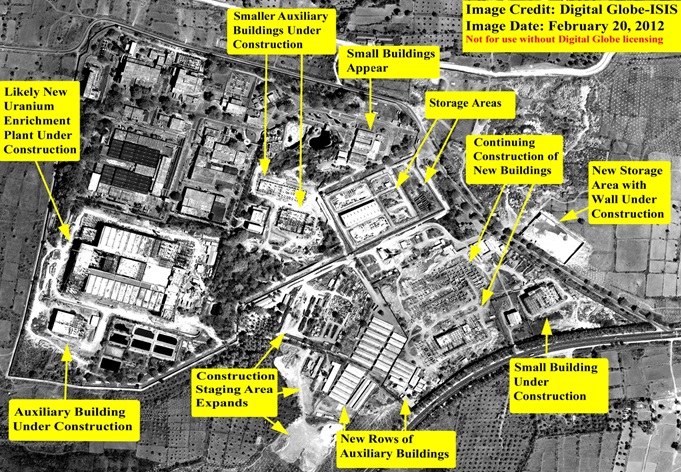Reports
Construction Finishing of Likely New Indian Centrifuge Facility at Rare Materials Plant Efforts to Build a Larger Centrifuge Complex Encounter Opposition
by David Albright and Serena Kelleher-Vergantini
December 4, 2013
Commercial satellite imagery shows that the construction is finishing of what appears to be a second gas centrifuge facility at the Rare Materials Plant (RMP), near Mysore. This new facility could significantly increase India’s ability to produce highly enriched uranium for military purposes, including more powerful nuclear weapons. India is also in the early stages of building a larger unsafeguarded centrifuge complex, the Special Material Enrichment Facility (SMEF), in Karnataka. However, as a result of domestic opposition alleging this facility is on environmentally sensitive lands, the National Green Tribunal, the government environmental oversight body, ordered major construction to halt temporarily in August 2013. Moreover, India’s enrichment plants are not under international safeguards or committed to peaceful uses. Thus, governments and suppliers of nuclear and nuclear-related dual use goods throughout the world should be vigilant to prevent efforts by Indian trading and manufacturing companies to acquire such goods for the new centrifuge complex in Karnataka as well as for the RMP.
India has been pursuing a gas centrifuge program to enrich uranium since the 1970s.1 In 1982, the Department of Atomic Energy decided to “construct a classified technology demonstration project,” the Rare Materials Project, as a unit of the Bhabha Atomic Research Center (BARC) at Mysore for uranium enrichment.2 Over the last three decades, this project has matured and allegedly proven itself at the demonstration scale, according to BARC. The success of this secret military enrichment program likely depended on illegal purchases of goods and technology abroad given that this unit aimed to overcome international sanctions imposed on India and trade controls of supplier nations, which BARC called the “Technology Denial Regime”.3
Although the status of this program is secret, ISIS has used for several years high resolution commercial satellite imagery to monitor the development of the Rare Materials Plant, near Mysore, which is believed to be the major site of this classified technology project and the home of India’s first major centrifuge plant. It started operations several years ago and is not under International Atomic Energy Agency (IAEA) safeguards. In 2010, India started building what appears to be a second larger centrifuge plant at the site. However, it is unclear if this new plant is to supplement or replace the first one.
India has reportedly made highly enriched uranium (HEU) at this site, and in 2011 its top nuclear official said this enrichment site is more than adequate for producing enough enriched uranium for its nuclear-powered submarine reactors.4 India’s newly developed Arihant-class nuclear-powered ballistic missile submarine is assessed as having an 80 megawatt-thermal nuclear reactor onboard and a core that contains approximately 65 kg of U-235 in HEU.5 Although the INS Arihant reactor went critical for the first time only in August 2013, India has started the construction of its second nuclear-powered submarine (INS Aridaman) and is believed to have plans to start the construction of a third one.6 India also may be making HEU at the RMP for nuclear weapons, in particular for thermonuclear weapons.
RMP Imagery
In an October 5, 2011 ISIS Imagery Brief, ISIS highlighted a new building at the RMP under construction adjacent to what is believed to be the original gas centrifuge plant (see figure 1). ISIS assessed that the new building under construction was likely to be a new gas centrifuge uranium enrichment plant.7 Additionally, ISIS noted the presence of several smaller, new buildings under construction and the presence of a construction staging area. Overall, in 2011, the new centrifuge plant appeared far from completion.
Imagery dated February 2012 showed that overall construction at India’s RMP had greatly advanced (see figure 2). The facility believed to contain the new centrifuge plant was much further along. It is apparent in the image that the facility is composed of two large rectangular structures with several adjoining auxiliary ones. The two larger rectangular structures could house the centrifuge cascades. Figure 2 also shows that several other buildings at the site are under construction and the staging area seems to have expanded.
April 2013 high resolution commercial imagery shows that the previous year witnessed further progress at India’s RMP (see figure 3). The building containing the suspected new enrichment facility appears externally to be nearly complete. Whether the plant is near operation cannot be determined from the image. The construction of other buildings appears externally complete as well, and the two storage areas seem to have developed further. Other buildings show signs of continued construction. The construction of two new buildings (bottom right in the image) seems to be complete, while other surrounding construction continues. The construction staging area continues to be present.
Although the similarity between the first and second enrichment buildings is obvious, the new suspected centrifuge plant is larger. In 2011 ISIS measured the perimeter of this plant to be approximately 210 meters by 150 meters,8 almost double the size of the original enrichment plant. If this new facility is indeed a new centrifuge plant, it is plausible to assume that it will house a much greater number of centrifuges. Consequently, India could have more than doubled its enrichment capacity, if the original building continues to function as an enrichment plant. If not, the new building would still represent a net growth in India’s enrichment capacity.
New Centrifuge Complex in Karnataka
In 2011, India announced its intention to build an industrial-scale centrifuge complex in Challakere Taluk, Chitradurga District (Karnataka).9 The plant, called the Special Material Enrichment Facility, will be under the BARC.10 India’s top nuclear official said in 2011 that the Special Material Enrichment Facility will not be safeguarded and will have multiple roles, both civilian and military.11 BARC recently confirmed this dual-use intention and described the facility as a “large scale facility” compared to the RMP’s demonstration scale, implying that the new site will also house gas centrifuges.12 This site could thus be dedicated to the production of both HEU and low enriched uranium (LEU) for military and civilian purposes.
Although BARC has finished some preparatory work at the site, major construction of this larger centrifuge plant has not yet started. Citizens and environmental groups have challenged the siting in Karnataka of this BARC facility and other adjacent facilities being built by India’s Defense Research Development Organization (DRDO) as illegal because of environmental concerns.13 As a result of the legal actions of the Environmental Support Group (ESG), India’s National Green Tribunal has stayed all ongoing work at these sites in August 2013.
ISIS will return to the Special Material Enrichment Facility in later studies, including estimating its enrichment capacity. Preliminary recommendations include that the Special Material Enrichment Facility should be limited to non-military uses, placed under IAEA safeguards, and built only after ensuring it is in compliance with environmental laws in a process that fully incorporates stakeholders. Moreover, India has allegedly pursued illegal means to outfit the RMP and is likely to attempt to do so for this new enrichment plant. Since neither is currently slated to be safeguarded nor used exclusively for non-military purposes, governments and suppliers of nuclear and nuclear-related dual-use goods throughout the world should now be vigilant to prevent efforts by Indian trading and manufacturing companies to acquire goods for the new centrifuge complex in Karnataka as well as continuing to remain vigilant about efforts to outfit the RMP.



1 See David Albright and Susan Basu,India’s Gas Centrifuge Enrichment Program: Growing Capacity for Military Purposes, Institute for Science and International Security (ISIS), January 18, 2007. 2 Statement of objections filed by the Respondent Nos. 10 (Bhabha Atomic Research Centre) and 12 (Defense Research and Development Organization, Before the National Green Tribunal (SZ) Chennai, Appl. No. 6 2013. 3 Ibid. For a discussion of some of the goods acquired abroad by RMP, see , India’s Gas Centrifuge Enrichment Program: Growing Capacity for Military Purposes, op. cit. 4 Saurav Jha, “Enrichment capacity enough to fuel nuke subs,” Saurav Jha, IBNLive Specials, Interview with Dr. Srikumar Banerjee, chairman of Atomic Energy Commission of India, November 26, 2011. 5 International Panel on Fissile Materials, Global Fissile Material Report 2013. 6 Ibid 7 Paul Brannan, Further Construction Progress at Possible New Military Uranium Enrichment Facility in India, ISIS Report, October 5, 2011, 8 Ibid. 9 The land for this facility was transferred to BARC in late 2010. 10 The enrichment facility is a part of a group of new defense and high-tech facilities slated to be built in the area. They include runways and test centers for long endurance Unmanned Aerial Vehicles (UAVs) and Unmanned Combat Aerial Vehicles (UCAVs) under India’s Defense research Development Organization (DRDO). 11 “Enrichment capacity enough to fuel nuke subs,” IBNLive Specials, Interview with Dr. Srikumar Banerjee, op. cit. 12 Statement of objections filed by the Respondent Nos. 10 (Bhabha Atomic Research Centre) and 12 (Defense Research and Development Organization), op. cit. In this document, the purpose of the new facility is stated to be meeting “the future requirement of upgraded fuel for use in power sector as well as other strategic purposes.” 13 Leo Saldanha, Forfeiting Our Commons, Environment Support Group Report, June 2013,

 twitter
twitter